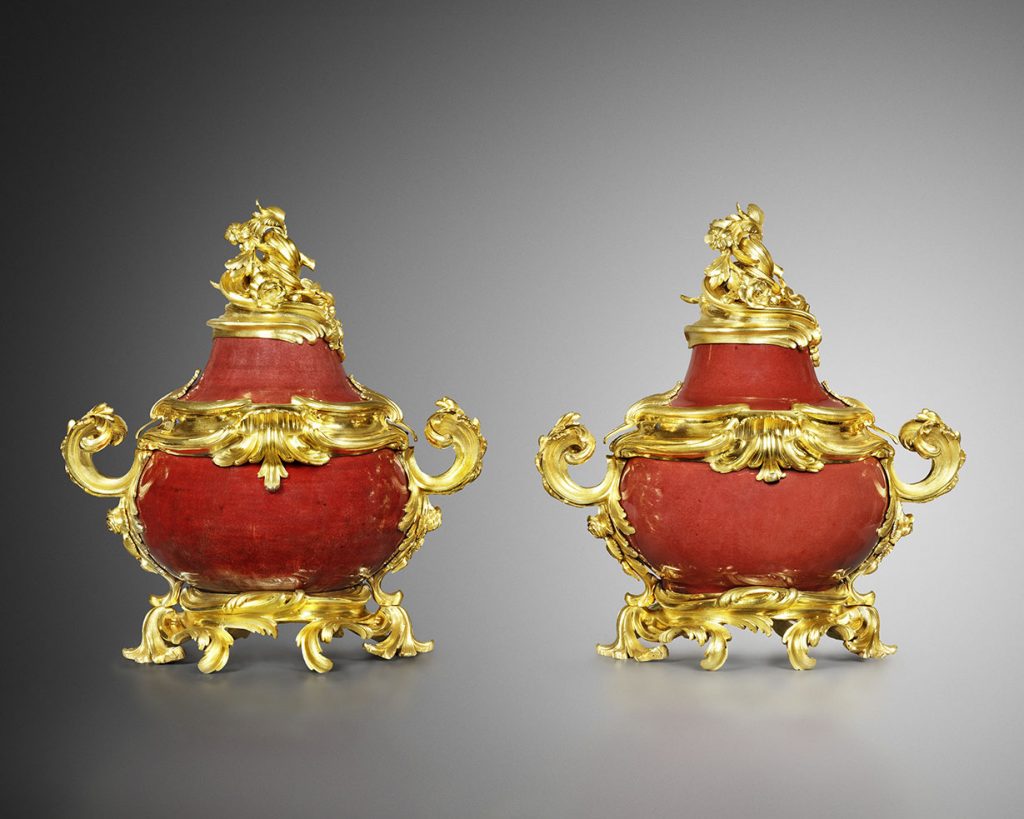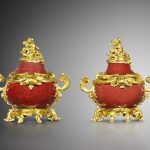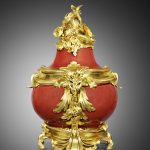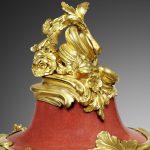A pair of Rothschild Louis XV sang de boeuf porcelain covered vases

A pair of Louis XV gilt bronze-mounted Chinese sang de boeuf porcelain covered vases – circa 1750
The porcelain 18th Century
The mounts attributed to Jean-Claude Chambellan Duplessis (1699-1774)
Height: 35 cm. (13 ¾ in.) Width: 32.5 cm. (12 ¾ in.)
Provenance :
Alfred Charles de Rothschild (1842-1918), Halton House, Buckinghamshire, and thence by descent to;
Lionel Nathan de Rothschild (1882-1942), Exbury House, Hampshire, and thence by descent at Exbury to;
Edmund Leopold de Rothschild (1916-2009), by whom sold to;
Alexander and Berendt Ltd., London, by January 1975, when sold to;
Juan de Beistegui (1930-2017)
Inventories :
Knight, Frank & Rutley, Halton. Schedule of Furniture, etc., [1918]. The Rothschild Archive, London, 000/174C/3
Christie’s, The Estate of Alfred de Rothschild Esq. Deceased. Halton House, Tring, [1918 and 1919]. The Rothschild Archive, London, 000/174C/4
Comparative Literature :
G.Sadde, ‘Jean-Claude Duplessis, « La liberté du style rocaille »’, L’Objet d’Art, no. 392 (June 2004), pp. 42-51.
A pair of Meissen porcelain soupières with identical mounts are in the Royal Collection at Windsor Castle (inv. RCIN 35249).
This strikingly beautiful pair of covered vases, each originally a late seventeenth century Chinese sang-de-beouf bottle vase, were cut at the neck and mounted in Paris around 1750. There, in a bold demonstration of the Rococo style then in vogue, chiselled and gilt bronze rocaille d’agrafes with acanthus leaves and other foliage scrolls were added, the removable lids fitted with a rich finial of florets, and the bodies flanked by handles. The attribution to Duplessis père is on stylistic grounds. His mounts are distinguished by their remarkable plasticity, seeming animated, from the base to the finial, by an impulse that gives the whole a continuous rhythm. This coherence bears witness to a flawless surety of line, and the achievement of impeccable technical mastery.
Rothschild provenance :
Often overlooked in favour of his cousin Ferdinand (best known for the collections now on display at Waddesdon Manor), Alfred de Rothschild’s discriminating taste enabled him to assemble one of the most important collections of 18th Century French decorative art of the late Victorian era.
Alfred inherited a Mayfair townhouse in Seamore Place on the death of his father Lionel in 1879, and an undeveloped Buckinghamshire estate at Halton, where he immediately built a palatial country retreat. In 1884, with Halton House finished, the Bond Street dealer Charles Davis was engaged to produce a lavishly illustrated catalogue, with photography done by Thomson of Grosvenor Street. Halton was photographed several times between then and 1892, as Alfred shared his pride in his collections. As these vases are in neither Davis’s catalogue nor any of the subsequent photographs, they must have been amongst many important acquisitions made by Alfred over the last three decades of his life in which he enriched his inheritance.
Work in the Rothschild Archive in London has now pinpointed their location at Halton in inventories taken at Alfred’s death in 1918. In the first inventory, compiled by Knight, Frank and Rutley, these vases are listed in the Bronzino Room, as “A pair of russet ground globular vases, ormolu mounts, scroll handles, on gilt stands, 13in.”. They are described more fully in the subsequent probate valuation drawn up by Christie’s as “A pair of Chinese sang-de-boeuf bowls and covers, mounted with Louis XV ormolu rims, handles and plinths, chased with branches of flowers, foliage and strap work”, and valued at £400. De Rothschild’s ‘Bronzino’ Room was named for its three-quarter length “portrait of a man” by the Florentine Mannerist. It served as a Smoking Room and was furnished with bronzes, objets d’art and other pieces of mounted porcelain.
In January 1918, on Alfred’s death, his collections were divided. Almina – his natural daughter and later the Countess of Carnarvon – was left the contents of Seamore Place, whilst his nephew Lionel received those of Halton. On Lionel’s death, during the Second World War, Exbury and its contents passed to his son Edmund (1916-2009). Unlike its nationally significant gardens, images of the interiors of Exbury House have never been circulated outside the Rothschild family. Facing post-war death duties and a continuing passion for his father’s gardens, Edmund disposed of much of his inherited art over the decades that followed. The vases were thus sold to the prominent London dealer Frank Berendt (information kindly communicated by Adrian Sassoon). From there, a few years later, they were sold once more, this time to Juan de Beistegui, thus embellishing the collections of a second great family of connoisseurs.



